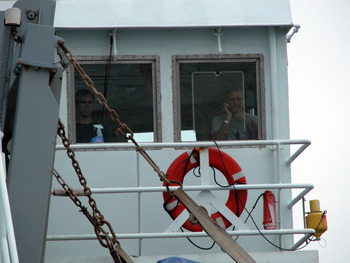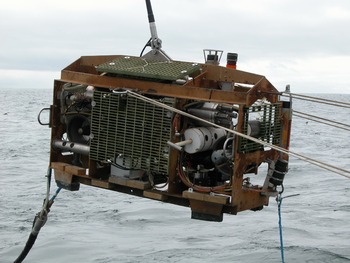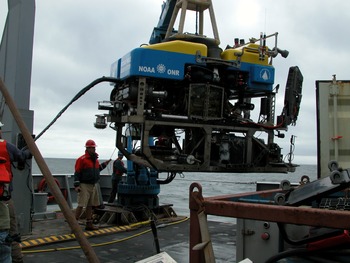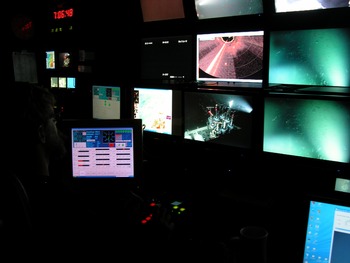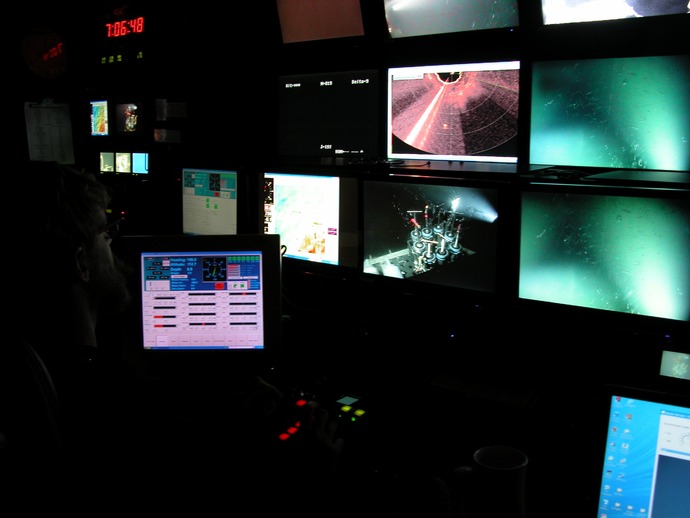as far as oceanographic research goes, I can’t imagine anything better than being here
For the first few days on board the ship, I was overwhelmed and rather intimidated by the unfamiliar environment and large number of incredibly knowledgeable people on board. However, these feelings quickly changed to ones of amazement and encouragement as I started exploring both the ship and the science that was taking place.
After my first shift of recording data in the van over Hydrate Ridge, I was hooked. The Jason van is a room filled with over 40 monitors tracking the remotely operated vehicle’s progress, screening live video of every angle of the seafloor, and swarming with the Jason crew and scientists trying to get their samples. Over my four-hour shift, while the R/V Thompson was located directly over Southern Hydrate Ridge, Jason circled the base of a 50-meter high carbonate pinnacle hundreds of meters below. Deb Kelley pointed out a pinkish circular blob to me on the seafloor and identified it as coral. I had spent the majority of my winter quarter doing an extra project that involved researching deep-sea coral, and it was astounding to see it broadcast on several of Jason’s cameras. Very little is known about these non-photosynthetic coral species—they’re only found below 200 meters water depth and therefore can only be accessed with robotic vehicles or submersibles. It was at this point that I realized how lucky I am to be experiencing this groundbreaking science and technology firsthand.
While in the Jason van, recording any changes in geology and biology on the seafloor, it’s incredibly easy to become completely immersed in this foreign world 800 meters below. Unique, transparent, tentacle-covered ctenophores are constantly floating by the cameras. Through the never-ending marine snow clouding the cameras, we sometimes see octopus, squid, and brightly colored rockfish. Venting and bubbling sites create vast white bacterial mats resembling snow-covered hills. Recently, I’ve realized that I must have found the appropriate field of study because when I notice a carbonate outcrop or abundance of old clam shells and I actually get excited.
When I finally leave the dark van and step out under the surprisingly blinding cloudy skies, it’s awe-inspiring to look out over the grey, choppy water and think of these underwater vehicles hundreds of meters below, giving all of us the experience of walking across the seafloor. Being a 24-hour ship, there is always something going on. If Jason and Sentry aren’t in the water, then the sediment and water column is being measured and sampled from the deck of the Thompson. Despite many people sleeping odd, infrequent hours, the enthusiasm never ceases and everybody perseveres in collecting samples and covering watches in the Jason van. Through my experience on this cruise so far, I’ve realized that two weeks just isn’t enough time on the boat. I have a feeling that my future is going to become devoted to finding spots on research cruises, because as far as oceanographic research goes, I can’t imagine anything better than being here. I’d challenge somebody to find another environment where there is such a breadth of knowledge and such eagerness for the subject of study. Everybody—engineers, biologists, geologists, oceanographers, marine techs, crew members, and students—are all working together and are excited to be part of such novel science.
Martha James
